What kind of dishes to cook in the microwave - an overview of five materials and the nuances of their use
The answer to the question of what kind of container to cook in the microwave so that the food remains safe and the device does not break down seems obvious: most housewives use plastic or glass. But other materials are also suitable for use in microwaves.
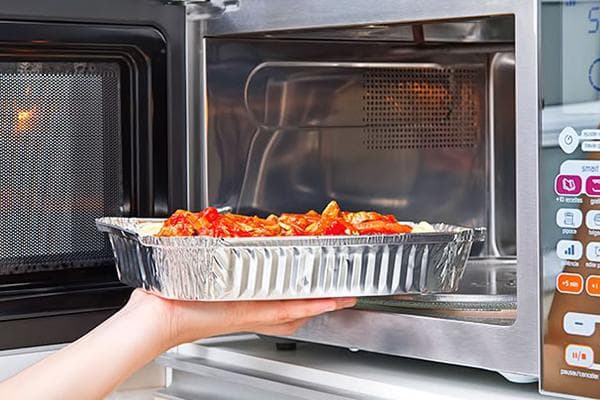
Metal utensils in the microwave - is it possible or not?
The instructions for any microwave oven contain a clause stating that the use of metal pots, mugs, plates and other utensils is prohibited. If you do not listen to the manufacturers' recommendations, you can say goodbye to the device prematurely. The fact is that microwaves do not pass through the crystal lattice of metals, but “hit” them - as a result, a semblance of a lightning discharge occurs.
Along with metal objects, foil containers also fell into disgrace. This is justified, because they are made of aluminum. However, some of them have a secret that allows you to heat and cook food in the microwave - these are perforations applied over the entire surface. The waves easily penetrate through the holes, so no sparks or explosions are observed.
It’s easy to make sure that a particular tray can be placed in a microwave oven - just look for a sticker on it in the form of a smiling emoticon with the inscription “microwave friendly”. If it is missing, it is better not to risk it.
Plastic dishes for microwave ovens
First of all, it is worth mentioning the fact that there are a huge number of types of plastic, including food plastic. Some of them can withstand heating up to 100 °C and above, others begin to melt even with a slight increase in temperature.
Polystyrene, polyvinyl chloride and polyethylene are not intended to be heated by any means. Therefore, you should not put it in the microwave:
- disposable plates, spoons and forks;
- disposable glasses (both transparent and colored);
- drink bottles;
- containers for yoghurt, sour cream and curd desserts;
- plastic bowls from blenders and mixers;
- kitchen bowls designed for washing fruit.
Polyamides and polypropylene are quite suitable for use in microwave ovens. It is from these materials that food containers are made, in which it is customary to take food with you.
When purchasing, it is important to pay attention not only to the presence of the “microwave safe” symbol, but also to the country of manufacture. Most plastic tableware is brought to Europe from China, and its quality usually leaves much to be desired. Even if the container does not melt, under the influence of heat and electromagnetic radiation, harmful substances can be released from it - for example, the well-known phthalates. When they get into food, they make it hazardous to health.
The main rule is to choose plastic utensils from trusted brands.
There is one more nuance - temperature. Plastic products always indicate how much heat they can withstand. If you exceed the maximum possible values by even a few degrees, the material will melt, after which it will be impossible to use such utensils for their intended purpose.The easiest way to “kill” a container is by trying to cook something sweet or fatty in it: sugar crystals, turning into caramel, can heat up to 188 ° C, and oils boil at 160–270 ° C.
Should you put glass in the microwave?
Fireproof glass is one of the best options for microwave use. Such plates and baking sheets can withstand temperatures up to 300 °C, do not crack, and are excellent at transmitting microwaves. The only disadvantage of such dishes is its cost.
But it is not recommended to place ordinary plates made of thin glass in a microwave oven. They are not designed for such a load and can explode right in the microwave, simultaneously damaging the device itself. It’s even worse if the dishes with hot food shatter into hundreds of fragments right in your hands - in addition to multiple cuts, the person will also receive burns.
Also on the list of “forbidden” items are:
- Glasses and shot glasses made of crystal — lead, silver and other metals are added to the composition of this type of glass. In addition, patterns are often cut into crystal, which means the wall thickness will not be the same.
- Any glass objects with a pattern. Since it is impossible to reliably know what the paint was made from, there is a risk that it contains metal components. The most dangerous are golden and silver colors - even if the pattern has already been erased, there is a possibility that traces of dye invisible to the eye remain on the surface.
- Jars and plates with microcracks, chips, air bubbles in the thickness of the glass. Due to the difference in thickness, they will heat unevenly. If the residence time in the oven exceeds 60 seconds and the power is set to maximum, an explosion is unlikely to be avoided.
- Jars of baby food and other canned goods, if they have a lid. Firstly, the lid is often made of metal, and secondly, the steam from the liquid heating up inside will rapidly expand. Sooner or later the pressure will increase so much that the lid will rip off. In this case, the microwave door may break and its internal walls will probably be damaged.
- Dishes that have just been taken out of the refrigerator. A sudden change in temperature will lead to cracking.
Ceramic cookware in a microwave oven - pros and cons
Often food is heated and cooked in the microwave using ceramic or clay containers. This is not prohibited, but there are some subtleties. For example, you should not expose thick-walled dishes to microwave heating, especially if there is something very cold in it - frozen cutlets, pancakes, berries.
It is important that the plates and baking sheets are covered with glaze not only on top, but also on the inside. The fact is that pure ceramics and those on which glaze is applied heat up differently, and accordingly, the risk of explosion increases.
Pottery is also fireproof and should be used if possible.
Compared to glass, ceramics do not transmit microwave radiation very well, but they have a number of advantages:
- inexpensive;
- rarely cracks;
- suitable for use in microwave ovens in grill mode or with convection turned on;
- allows you to get a beautiful crispy crust on meat products without adding oil.
Are cardboard and microwave compatible?
Many people are surprised by this fact, but cardboard containers withstand heating in a microwave oven well. They do not catch fire, do not emit unpleasant odors, and are transparent to radiation.If you need to reheat buns, bread, pizza and other baked goods, it is best to place it not on a plate, but on a paper napkin or piece of cardboard box. The material will absorb excess moisture and the dough will not seem wet. It is also allowed to wrap sausages, cutlets, pancakes and other solid foods in paper.
You should not use oiled parchment to heat food: it can burst into flames at any second. Cardboard glasses and plates coated with wax are also not suitable - they are not designed for high heat, so the wax will melt and be absorbed into the food. After this you will not be able to eat it.
Finally, it is worth noting that not only the material from which the container is made is important, but also its shape.
- Vessels with rounded edges show the best results - they heat food quickly and evenly. But rectangular containers and plates are their complete opposite. The fact is that many waves are concentrated in the corners, respectively, the temperature of the food rises faster, moisture evaporates from the food more quickly, and as a result they end up partially dried out or even burnt.
- The size of the sides also matters - in tall containers the heating process is slower, especially if the food is in a thick layer.
Don't forget about the special plastic lids. They prevent excessive evaporation of water, making food tastier. They have a hole in them to equalize steam pressure, so do not try to replace the microwave lid with any other one.

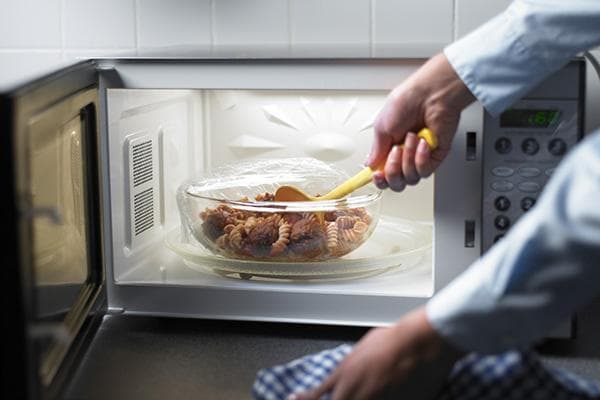
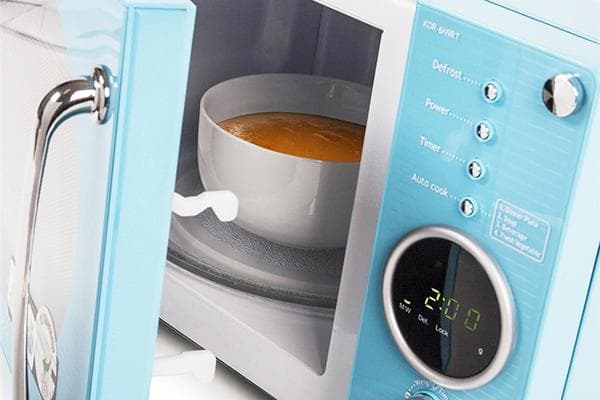
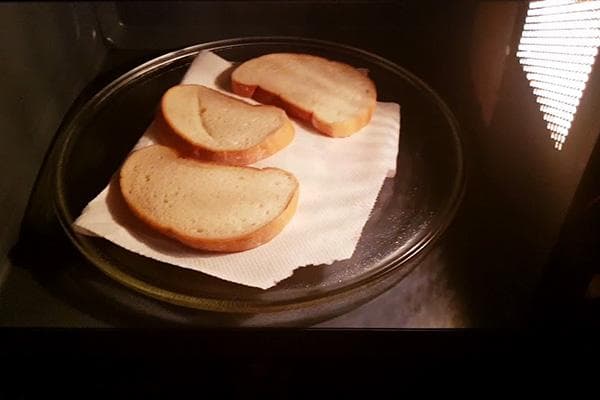
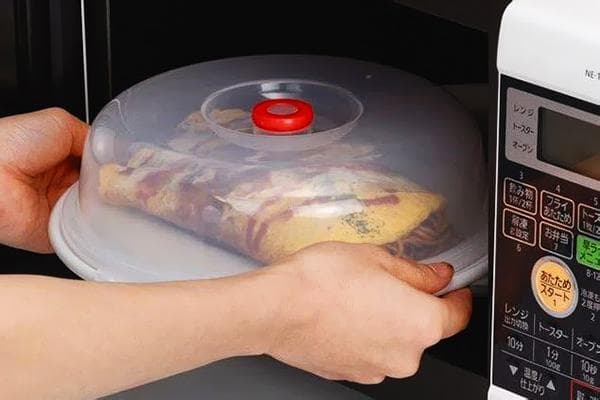
I tried heating the rolls and bread in the microwave on a napkin rather than on a plate. And they really aren't wet. The napkin absorbed everything.